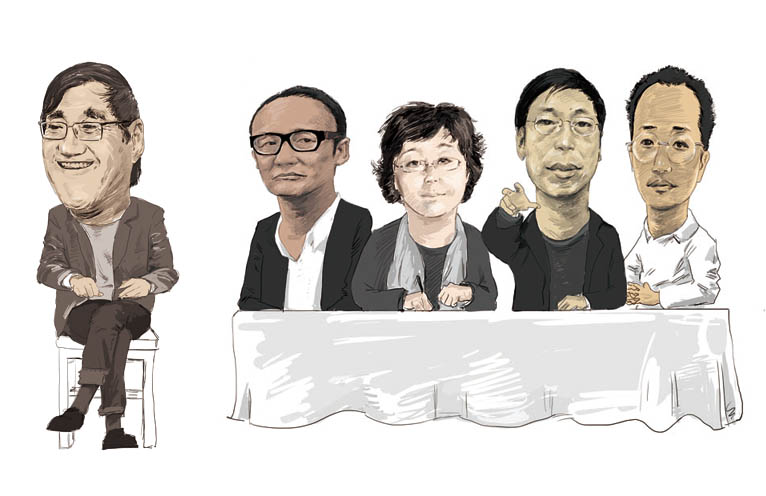BORDER PATROL
| August 3, 2010 | Post In LEAP 4
Symposium on “The Borders of Art”
DATE: 2010.5.30 / LOCATION: CENTRAL ACADEMY OF FINE ARTS MUSEUM, VIP LOUNGE
Held in conjunction with “Pan Gongkai Conceptual Art Exhibition”
FROM LEFT
PAN GONGKAI
Art theorist and educator; President, China Central Academy of Fine Arts (CAFA)
ZHU QINGSHENG
Professor of Art, Peking University
AN YUANYUAN
Director, Art and Literature Department, PRC Ministry of Culture
YIN SHUANGXI
Deputy Editor, CAFA Art Research; Director, China Sculpture Institute
QIU ZHIJIE
Artist; Associate Professor, Total Art Department, China Academy of Art
Pan Gongkai:
This thing of mine has been more than a decade in the making. It’s a big concept, as is the frame, actually. There are two levels inside the frame. One is of artwork from the present, including Eastern and Western or aboriginal art of today; most everything can be included. I wanted to interrogate our notion of the art object as a thing that exists. The word “artwork” refers to something we make, not the process of making. I want to find the dividing line between real life and the artwork. That is my aim. Hence the long article I wrote on the “border” issue, and hence the exhibition today. All of my work is an investigation of the dividing line between artwork and life.
Which is to say that without illogical composition there is essentially no artwork. This artwork here, it provides a conscience for artwork. If the artwork is not of illogical composition, it’s of no use, there’s no provocation, no deception, no enlightenment of the brain. It goes to follow, then, that aesthetic mentailty of the isolation we want to achieve and the network of logical reality becomes difficult to realize. I.e. without illogical composition, there’s no way to give rise to the tools of deception or enlightenment, and thus the right aesthetic mentality is difficult to achieve. Which isn’t to say it’s impossible. Just that it’s comparatively difficult.
Zhu Qingsheng:
You might not have started to question this, but Professor Pan already has. Just now he asked what the border between art and life is. But when we ask this question, we imply another: What kind of art does “art” refer to? And “life,” what does that refer to? If you all open your books to page 85, you’ll see that “life” is defined as daily life. And Professor Pan has stated that “art” refers to Western modern art. These distinctions are key; if we are just discussing art and life in the abstract, we can say that art is life, or life is art without consequence…is there really any difference to speak of? So we have to be clear on the question: how does daily life become a work of Western contemporary art? I’d like to pose another question: who has the power to say who is an artist and who isn’t? And what is an artist’s identity founded on? Whoever gets to decide this, where does his hegemony come from? Where does he get off stripping ordinary people of their right to make art?
Yin Shuangxi:
I’ve got a feeling that Professor Pan’s work and his theoretical analysis are just one big contradiction. I see them as being two different methods. As a theorist, Professor Pan is trying hard to define the border of art. Moreover, he’s expressed his logic clearly and in an ordered manner. He wants to confirm where that dividing line is. But as an artist, Professor Pan is blurring the dividing line between art and life, constantly pushing it further and further. Yesterday he said that the dividing line is dynamic, such that artists are given certain rights and possibilities. When Professor Pan is discussing the borderline, he’s doing so from theoretical and ideological perspectives. This so-called line is a publicly endorsed entity, a publicly approved system of directions. If it were devised by man, nobody would acknowledge it. It only works to the extent that everyone acknowledges it. If you draw a line of your own, you’ll be faced with the whole world up against you. This line has to be universally known.
Qiu Zhijie:
I believe that even if this exhibition did not include Pan’s paintings of lotus flowers, one could sense the Chinese scholar in his installation [which recreates a space capsule.] As soon as his eyes leave the papers on top of the desk inside the spaceship, the universe appears, the history of this world, every place in perfect order. He immediately thinks about two thousand years ago or ten thousand years in the future. This is an extremely Chinese idea.
An Yuanyuan:
As this exhibition materialized before my eyes, I was very happy. For Professor Pan’s overall condition, I’d like to express my admiration and understanding. I know the extent of his abilities. In fact, we’ve known each other for more than twenty years. Everything he does is done with great effort. In certain areas and from a culturally strategic point of view, he has been a pioneer. Looking back, what he’s done has truly great value and significance, for sociology, history, and art itself.


